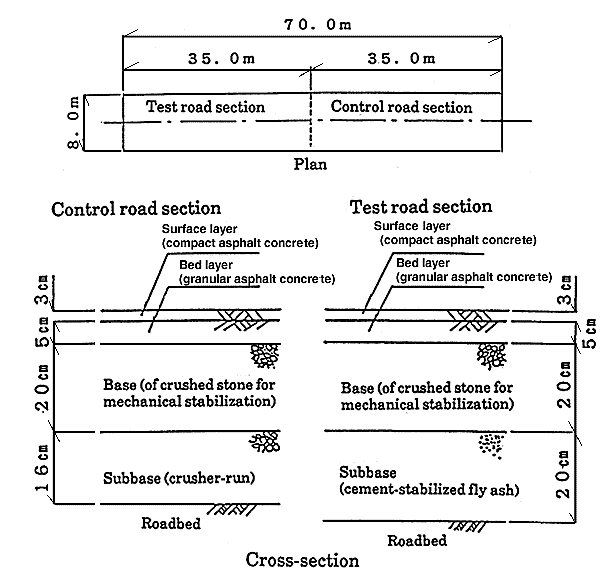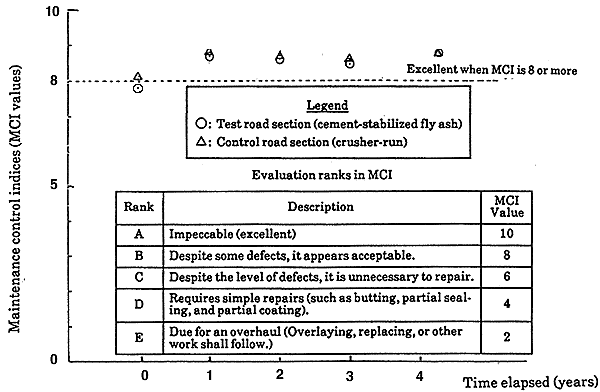Waste Treatment Technology in JAPAN
Recycling
(1) Material test
Fig. 1 Overview Plan and Cross-section of Experimental Construction
(Private Road at Nanko Power Station)
(1) Quality
- According to the maintenance control indices (MCI) provided by the Ministry
of Construction, the long-term endurance duration proved to be excellent
because the five-year follow-up examination revealed little or no
irregularity across the road or irregularity along the road, deflection,
or percentage of cracks.
(See Fig. 2.)
Fig. 2 Transitions in Maintenance Control Indices Provided by the Ministry
of Construction (Private Road at Nanko Power Station)
(2) Facility of work, and other problems1. Overview
Thermal power plants produce coal ash, and can supply it to civil engineers who can put it to effective use as road base material. The Kansai Electric Power Co., Inc. paved its private road using cement-stabilized fly ash as a road base material. The demonstration test verified its quality and the facility of the work.
2. Method of Demonstration and Testing
The material test of supplied coal ash detected no harmful matter. The mixture was then tested as to its strength capabilities as follows:
(Physicochemical analysis, harmful matter elution analysis)
- The test results verified that the material complied with the criteria
specified in the "Prime Minister's Decree for Standardizing Industrial
Wastes That Contain Metals" issued from the Prime Minister's Office in
1980.
(2) Mixture test
- After a seven-day curing period, the road base shall have the unconfined
compression strength qu of 30 kgf/cm2; the subbase, 10 kgf/cm2. Thus,
13% cement served as additive content in the road base; 6% cement, in the
subbase.
(3) Structure design
- The surface paving thickness was determined so that the test road section
(with cement-stabilized fly ash) had a surface paving thickness equal to
the converted equivalent of the control road section (with crusher-run and
other gravel). (See Fig. 1.)

3. Demonstration Test Results
- The strength of the road surface meets the requirements specified in the
Plant-recycled Paving Technique Guidelines drawn up by the Japan Road
Association.

-It was difficult to stir the mixture for uniformity, to readjust the water
content,and to compact loose material. And it was necessary to halt
construction work for curing time. Solving such problems involves
standardizing material treatment, construction technique, maintenance, and
other procedures.
Office of Civil Engineering and Architecture
3-22, Nakanoshima, 3-chome, Kita-ku, Osaka 530-8270, Japan
Tel: (06)446-9447
Fax: (06)441-3879